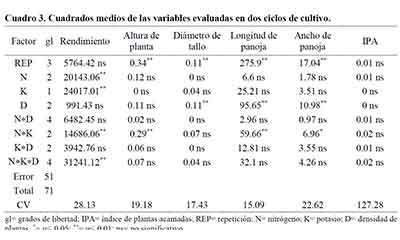Plant densities and fertilization doses in the cultivation of amaranth
DOI:
https://doi.org/10.29312/remexca.v12i5.2769Keywords:
Amaranthus hypochondriacus L., conventional direct sowing system, technical itineraryAbstract
The objective of this research was to evaluate the response of Amaranthus hypochondriacus L. race Mercado to plant density and fertilization doses in the variables: yield, plant height, stem diameter, panicle size, and index of plants with lodging. The study factors were: planting density (D) (156 250, 208 333 and 260 417 plants ha-1), nitrogen levels (40, 80 and 120 kg ha-1), potassium levels (zero and 20 kg ha-1) and application of 40 kg ha-1 of phosphorus as a constant. The arrangement of treatments consisted of a 3x3x2 factorial in an experimental design of completely random blocks with four repetitions and 18 treatments. The experiment was conducted in the 2017 and 2018 cultivation cycles in Tochimilco, Puebla, Mexico. The cultivation practices were carried out according to the technical itinerary of the conventional direct sowing system, which consists of placing in each sowing hole a variable number of seeds to ensure that in each hole several plants grow and then perform a thinning, in which the smallest plants are uprooted and three, four or five plants are left in each sowing hole depending on the experience of each farmer. The results show highly significant differences (p< 0.01) in yield, plant height, length and width of panicle by individual effects and interactions of D, N*K and N*K*D. It was concluded that the decision made by producers to leave three, four or five plants per sowing hole is a decisive decision in the production of amaranth.
Downloads

Downloads
Published
How to Cite
Issue
Section
License
Copyright (c) 2021 Revista Mexicana de Ciencias Agrícolas

This work is licensed under a Creative Commons Attribution-NonCommercial 4.0 International License.
The authors who publish in Revista Mexicana de Ciencias Agrícolas accept the following conditions:
In accordance with copyright laws, Revista Mexicana de Ciencias Agrícolas recognizes and respects the authors’ moral right and ownership of property rights which will be transferred to the journal for dissemination in open access. Invariably, all the authors have to sign a letter of transfer of property rights and of originality of the article to Instituto Nacional de Investigaciones Forestales, Agrícolas y Pecuarias (INIFAP) [National Institute of Forestry, Agricultural and Livestock Research]. The author(s) must pay a fee for the reception of articles before proceeding to editorial review.
All the texts published by Revista Mexicana de Ciencias Agrícolas —with no exception— are distributed under a Creative Commons License Attribution-NonCommercial 4.0 International (CC BY-NC 4.0), which allows third parties to use the publication as long as the work’s authorship and its first publication in this journal are mentioned.
The author(s) can enter into independent and additional contractual agreements for the nonexclusive distribution of the version of the article published in Revista Mexicana de Ciencias Agrícolas (for example include it into an institutional repository or publish it in a book) as long as it is clearly and explicitly indicated that the work was published for the first time in Revista Mexicana de Ciencias Agrícolas.
For all the above, the authors shall send the Letter-transfer of Property Rights for the first publication duly filled in and signed by the author(s). This form must be sent as a PDF file to: revista_atm@yahoo.com.mx; cienciasagricola@inifap.gob.mx; remexca2017@gmail.
This work is licensed under a Creative Commons Attribution-Noncommercial 4.0 International license.


